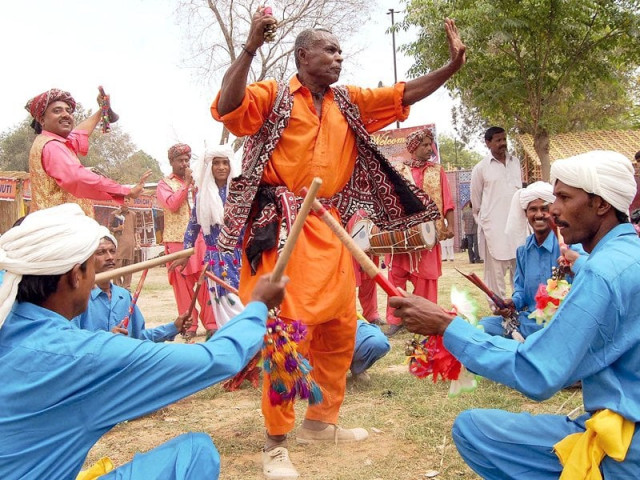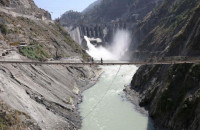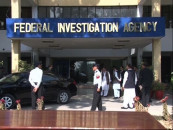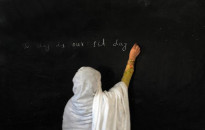Master artisans, craftspeople attract visitors to Lok Mela
Hundreds throng to see the culture of the country, sample regional delicacies

Sindhi cultural dancers move to the beat on the second day of Lok Mela. PHOTO: INP
The 10-day festival is featuring cultural performers, artisans and chefs from all parts of the country including the four provinces of Punjab, Balochistan, Khyber-Pakhtunkhwa (K-P), Sindh and the regions of Gilgit-Baltistan (G-B) and Azad Jammu and Kashmir (AJK) are showcasing their talents in dedicated pavilions.
Visitors can enjoy folk music, dances all the while sampling traditional cuisines in the aesthetically designed and colourful pavilions.
This year, a large number of female artisans have been invited to participate in the festival. Craftswoman Aziz Fatima from Balochistan said that she practices Balochi embroidery through a method that has been passed down in her family for generations. Noting that the method is centuries’ old, both she and her mother devoted many years of their lives to perfect their craft.
Now, she says she is keenly teaching the next generation to carry on the tradition. In this regard, she said that she has trained many girls in her locality to ensure that this tradition continues.
Farhat Bibi from the conservative Dera Ismail Khan displayed her skills as a wood lacquer work. The word ‘lack’, `lac`, `leca’ or `laksha’ in different languages is significantly derived from the Persian word `lac’ or Hindi word `lakh’ meaning a hundred thousand.
It indicates the multitudes of insects required to produce `lac’. Locally, it is called `jundri’ or `jandi ka kaam’ which forms an intrinsic part of woods-craft in three provinces of Pakistan It involves the process of applying layers of `lac’ of different colours on wood, while the material is rotated on a simple wooden lathe machine.
Patterns are then etched into the wood with the help of thick iron needle on the surface, exposing each colour according to the requirements of traditional patterns.
Pari Bibi from the coastal town of Badin in Sindh weaves `Farasi’ (traditional rug). The 74-year-old artisan is an expert in the art of weaving since her childhood.
Craftswomen Sultana and Shamim Bano from the mountain stepped colony of Karaimabad in Hunza were actively demonstrating their workmanship in the G-B pavilion. A practitioner of the traditional Hunza embroidery and carpet work, she can be found in the pavilion in front of an Anarkali façade of the Lok Virsa Heritage Museum.
Ameer Bukhsh, an artisan who uses natural dyes with wooden blocks from the Kahror Pacca area of Punjab, showcased his work in the Punjab pavilion. The pavilion’s entrance is modelled after the entrance gate Ghazi Khan’s tomb, the founder of Dera Ghazi Khan.
The woodblock and dye work traces its roots back to lower Indus valley encompassing southern Punjab and all of Sindh.
Bukhsh said that he has not only trained his family members but also trained many other artisans in the craft of block printing on textiles.
Like Farhat from Dera Ismail Khan, Muhammad Riaz is an expert in lacquer art (Silanwali style) from Silanwali area in the Sargodha District of Punjab. Hailing from a famous family of lacquer craftsman, Riaz said that he is working to keep the art of his forefathers alive in a modern world where many traditional crafts have been replaced by either modern chemicals or machines.
The `Silanwali’ technique — named after the expertise perfected by craftsmen from this town — is an altogether different form from lacquer practised in other areas. It is a physically intensive process which requires patience and dedication to complete, Riaz said.
More than 55 master artisans from all over Punjab are showcasing their work at the Punjab pavilion which has been set up in collaboration between the Punjab Council of the Arts in Rawalpindi and the Punjab Information and Culture Department. Artisans for woodwork, lacquer art, khaddar, vegetable dying, mirror work, truck art, doll making, khussa weaving, showcased their abilities in Punjab pavilion.
Even though the K-P pavilion has a lot of traditional crafts to offer, the cool winter air and rain clouds hovering above meant that many visitors to the festival preferred to visit the K-P pavilion for the scrumptious ‘chappal kababs’ being prepared before them.
Apart from the chappal kababs, the K-P pavilion also offered a variety of other mouthwatering traditional foods such as `patta seek’ and `lamb karahi’ which could be washed down with a cup of traditional `kahwa’ at a specially decorated Qehwa Khana.
Published in The Express Tribune, November 18th, 2019.



















COMMENTS
Comments are moderated and generally will be posted if they are on-topic and not abusive.
For more information, please see our Comments FAQ